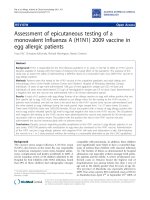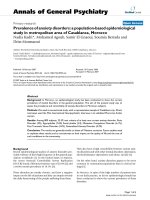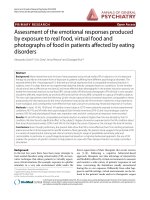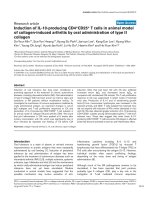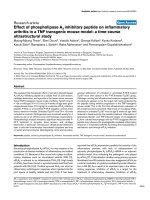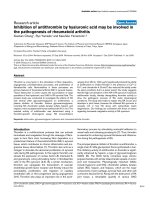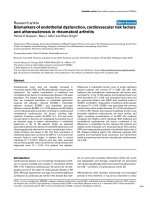Báo cáo y học: " Assessment of disease-severity scoring systems for patients with sepsis in general internal medicine departments" pdf
Bạn đang xem bản rút gọn của tài liệu. Xem và tải ngay bản đầy đủ của tài liệu tại đây (284.15 KB, 7 trang )
RESEARCH Open Access
Assessment of disease-severity scoring systems
for patients with sepsis in general internal
medicine departments
Nesrin O Ghanem-Zoubi
*
, Moshe Vardi, Arie Laor, Gabriel Weber and Haim Bitterman
Abstract
Introduction: Due to the increasing burden on hospital systems, most elderly patients with non-surgical sepsis are
admitted to general internal medicine departments. Disease-severity scoring systems are used for stratificat ion of
patients for utilization management, performance assessment, and clinical research. Some widely used scoring
systems for septic patients are inappropriate when rating non-surgical patients in a non-intensive care unit (ICU)
environment mainly because their calculations require types of data that are frequently unavailable. This study
aimed to assess the fitness of four scoring systems for septic patients hospitalized in general internal medicine
departments: modified early warning score (MEWS), simple clinical score (SCS), mortality in emergency department
sepsis (MEDS) score, and rapid emergency medicine score (REMS).
Methods: We prospectively collected computerized data of septic patients admitted to general internal medicine
departments in our community-based university hospital. We followed 28-day in-hospital mortality, overall in-
hospital mortal ity, and 30- and 60-day mortality. Using a logistic regression procedure we calculated the area under
ROC curve (AUC) for every scoring system.
Results: Between February 1
st
, 2008 and April 30
th
, 2009 we gathered data of 1,072 patients meeting sepsis criteria
on admission to general internal medicine departments. The 28-day mortality was 19.4%. The AUC for the MEWS
was 0.65 -0.70, for the SCS 0.76-0.79, for the MEDS 0.73-0.75, and for the REMS, 0.74-0.79. Using Hosmer-Lemeshow
statistics, a lack of fit was found for the MEDS model. All scoring systems performed better than calculations based
on sepsis severity.
Conclusions: The SCS and REMS are the most appropriate clinical scores to predict the mortality of patients with
sepsis in general internal medicine departments.
Introduction
Sepsis is a prevalent, serious and resource-consuming
medical conditio n. The incid ence of sepsis increased by
8.7% annually from 1979 to 2000 [1]. Sepsis is the 10th
leading cause of overall death in the USA, and the sixth
when including pneumonia and influenza [2]. Although
the in-hospital mortality rate from sepsis decreased
from 27.8% (reported for the period from 1979 to 1984)
to 17.9% (reported for 1995 to 2000), the absolute num-
ber of deaths increased due to its increasing incidence
[1]. The markedly increased incidence resulted in an
estimated US$16.7 b illion annual cost related to severe
sepsis in the USA [3].
Due to limited ICU resources, most septic patients,
including patients with severe sepsis, are currently
admitted to general departments [4,5]. The aging of
Western populations is an impo rtant contributing factor
to the increasing incidence of sepsis in recent years,
because older people are more prone to infections. All
in all, elderly patients with sepsis o ccupy an increasing
proportion of h ospital beds in general internal medicine
departments.
In 2004, critical care and infectious disease experts
developed management guidelines for severe sepsis and
septic shock t hat were updated in 2008 under the
auspices of the Surviving Sepsis Campaign (SSC) [6,7].
* Correspondence:
Carmel Medical Center. The Ruth and Bruce Rappaport Faculty of Medicine.
Technion - Israel Institute of Technology, Technion City, Haifa 32000, Israel
Ghanem-Zoubi et al. Critical Care 2011, 15:R95
/>© 2011 Ghanem -Zoubi et al.; licensee BioMed Centra l Ltd. This is an open access article distributed under the terms of the Creative
Commons Attribution License (http ://creativecommons.org/licenses/by/2.0), which permits unrestricted use, distribut ion, and
reproduction in any medium, provided the original work is properly cited.
The SSC aimed to reduce mortality fr om sepsis via a
multi-point strategy, primarily by building awareness,
improving diagnosis and increasing the use of appropri-
ate treatment. In this respect, there is a growing need
for appropriate tools to assess severity of sepsis, and to
enable the early detection of complex cases that warrant
particular attention with rapid and appropriate
treatment.
Many disease severity scoring systems related to sepsis
have been developed over the years [8-12]. Most meth-
ods were d evised for assessment of patients with sepsis
who underwent surgery and were admitted to the ICU
[13], or for specific infectious c onditions (e.g., bactere-
mia, pneumonia) [10,12]. These classifications may not
be appropriate for patients with sepsis who are being
admitted to general internal medicine departments.
Only a few scoring systems exist that are not
restricted to a specific medical condition or ICU setting.
The Modified Early Warning Score (MEWS) is a simple
physiological scoring system suitable for bedside applica-
tion that was validated in a prospective cohort study on
709 medical emergency admissions. It is not a disease-
specific score. It was found that a MEWS of more than
four predicts increased risk of mortality with an odds
ratio (OR) of 5.4. The area under the curve (AUC) for
predicting 60-day mortality was 0.67 [14]. The Simple
Clinical Score (SCS) was developed and validated on
9,964 patients admitted as acute medical emergencies. It
is also not disease-specific. The SCS receiver operating
characteristics (ROC) curve for 30-day mortality had an
AUC of between 0.85 and 0.9 [15]. The Mortality in
Emergency Department Sepsis (MEDS) score was devel-
oped for use with patients “at risk for infection”.The
study included 3,179 surgical and medical patients. It
was found to predict 28-day in-hospital mortality with
an AUC of 0.82 and 0.78 for derivation and validation
groups, respectively [16]. The Rapid Emergency Medi-
cine Score (REMS) was developed in non-surgical adults
admitted to emergency departments over a period of
one y ear. The AUC for predicting in-hospital mortality
was found to be 0.85 [17].
The current study aimed to prospectively compare the
prognostic value of these four general scoring systems
in patients with sepsis upon admission to general inter-
nal medicine departments.
Materials and methods
Patients
The study included consecutive patients admitted to a
110-bed general internal medicine department from
1 February 2008 to 30 April 2009 in a 450-bed commu-
nity-based university hospital in Haifa, Israel. All
patients were over 18 years of age, and h ad a pr esumed
diagnosis compatible with sepsis. The patients were
identified automatically using the definition of sepsis
given by the American College of Chest Physicians
(ACCP)/Society of Critical Care Medicine (SCCM) Con-
sensus Conference in 1991 [18], that is, any patient
admitted with suspected infection and at least two of
the criteria of Systemic Inflammatory Response Syn-
drome (SIRS): (1) a temperature of more than 38°C or
less than 36°C; (2) an elevated heart rate greater than 90
beats per minute; (3) tachypnea, manifested by a respira-
tory rate greater than 20 breaths per minute or hyper-
ventilation, a s indicated by a partial pressure of arterial
carbon dioxide of less than 32 mmHg; (4) an alteration
in the w hite blood ce ll count, such as a c ount greater
than 12,000/cu mm, a count less than 4,000/cu mm; or
the presence of more than 10% immature neutrophils.
No exclusion criteria were employed.
Data collection
We developed a computerized database that was incor-
porated into our electronic medical record (EMR) sys-
tem. The computerized system identified patients with
presumed sepsis according to the criteria listed above.
Thereafter, the physicians were instructed to input the
required data necessary for the examined scoring sys-
tems (Table 1) via a mandatory questionnaire that
Table 1 Parameters required for the calculations of the
examined scores
MEWS REMS MEDS SCS
Age X X X
Nursing home resident X X
Mental status X X
Functional status X
Terminal illness X
Diabetes (type I or II) X
Lower respiratory tract infection X
New stroke on presentation X
Heart rate X X X
Temperature X X X
Systolic blood pressure X X
Mean arterial pressure X
Respiratory rate X X X X
Peripheral oxygen saturation X X X
AVPU score X
Glasgow coma scale X
Coma without intoxication or overdose X
Breathless on presentation X
Septic shock X
Abnormal ECG X
Platelet count X
Percent bands in differential count X
AVPU, alert, responding to voice, responding to pain, unconscious; MEDS,
mortality in emergency medicine sepsis score; MEWS, modified early warning
score; REMS, rapid emergency medicine score; SCS, simple clinical score.
Ghanem-Zoubi et al. Critical Care 2011, 15:R95
/>Page 2 of 7
included structured i nput of data, alongside automatic
data gathering.
Data related to current illn ess included vital signs,
such as heart rate, respiratory r ate, body tempera ture,
systolic and diastolic blood pressures, and oxygen
saturation. The mean arterial pressure was calculated.
Physicians were instructed to register the worst value
until admission to the department , including emergency
department values. Other finding s at presentation
included breathlessness, new stroke, intoxication or
overdose, lower respiratory tract infec tion, AVPU (Alert,
responding to Voice, responding to Pain, Unconscious)
score, Glasgow coma scale score, abnormal e lectrocar-
diogram recording (other than sinus tachycardia or bra-
dycardia), as well a s clinical staging of sepsis (sepsis,
severe sepsis, septic shock) based on ACCP/SCCM
definitions.
Demographics and co-morbidities w ere also gathered:
age, functional status, unable to stand unaided prior to
current illness, bedridden, type of residence, mental sta-
tus, diabetes mellitus, and terminal illness. Laboratory
results required for scoring calculations were drawn
automatically and included platelet count and band per-
centage in the differential count.
Follow up
We recorded follow up survival rates for at least 60 days.
For patients who died, we recorded whether the death
occurred in hospital or after discharge. For every exam-
ined scoring system, we checked its fitness to predict
overall death rates in different intervals of time (1, 5, 10,
30 and 60 days), as well as 28 days and overall in-hospital
mortality rates. For post-disch arge death, data were
extracted from our EMR system, which is supplied with
death data from the Ministry of Interior records.
Statistical analysis
We described the distribution of our study group by cal-
culating mean, range, and sta ndard deviation. For cate-
gorical variables we calculated the distribution and
cumulative distribution.
For determining the quality of the examined scoring
systems we used logistic regression. For each patient w e
recorded survival outcomes (alive or dead) in the corre-
sponding intervals of time for the four examined survival
scores. For each outcome and score we built a specific
logistic model predicting the probability of survival. Spe-
cificity and s ensitivity were calculated by using varying
cut-off points from zero (all predicted dead) to one (all
predicted alive). For each decision probability we
recorded the one-specificity versus sen sitivity on the
ROC curve. The estimated AUC computed by the trape-
zoid rule is the criterion for score performance for pre-
dicting the outcome. We compared logistic model
performance of the four scores for a specific outcome, by
comparing the AUC of the ROC curves. ROC c ompari-
sons for the four scores, for a specific outcome, were per-
formed by using a contrast matrix. We used the MEWS
curve as the reference curve for comparisons.
We created a new score for predicting mortality utiliz-
ing the classical “sepsis stages” (i.e. sepsis, severe sepsis,
and septic shock). We divided our patients into four
groups with ascending severity: 1 = SIRS; 2 = sepsis; 3 =
severe sepsis; 4 = septic shock. We modeled by logistic
regression the log odds for d ying after a specific period
(one day, five days, in hospital, etc). Sepsis stage was
used as the categorical explanatory (independent) vari-
able. The solution of the model is the weight for each
category of sepsis group, while the categories are not
equally departed from each other. The weights for each
model are the best possible weights (minimal Log likeli-
hood) for our sample of patients. Thereafter, we calcu-
lated the AUC of the ROC curve for its predictive value,
and c ompared it with the four scores presented in our
work. The curve comparison was based on the method
proposed by DeLong et al. [19]. Predictive accuracy for
each model was assessed by comparing the observed
and the expect ed mortality in different intervals of time
by using the Hosmer-Lemeshow (HL) g oodness-of-fit
test. The chi square test was carried out to determine if
the observed and expected frequencies are significantly
different. A P value greater than 0.05 for the HL test is
considered suggestive of a calibrated model.
For our calculations we used SAS 9.2 software (Proce-
dure univariate freq and logistic (SAS, Cary, NC, USA))
[20].
The study was approved by the Carmel Hospital Insti-
tutional Review Board. The need for informed consent
was waived.
Results
Study population
During the 15-month study period, 1,072 patients
admitted to general internal medicine departments met
the criteria of sepsis on their admission. The mean age
of our study group was 74.7 ± 16.1 years, with 49% of
the study population being over 80 years of age, and
11.7% over 90 years of age. Male to female ratio w as
1.08:1. Most of the study population (96.2%) was
admitted through the emergency department, with the
rest being transferred from other departments in t he
hospital. At admission, 5% of our study cohort fulfilled
the criteria for septic shock, and 9.3% for severe sepsis.
Seventy-seven patients (7.2%) were transferred to other
departments, including 19 patients (1.8%) transferred to
the ICU. Suspected source ofinfectiononadmission
was as follows: pneumonia (43%), urinary tract infection
(27%), unknown source (14%), skin and soft tissue
Ghanem-Zoubi et al. Critical Care 2011, 15:R95
/>Page 3 of 7
infections (6.3%), and other source (9%). Data for 17
patients (1.5%) were missing.
Outcomes
The mean time to last follow up was 90 ± 62 days. Dur-
ing this follow-up period , 387 patients died with an
overall mortality rate of 36.1%. The 28-day in-hospital
mortality was 19.5%. The overall in-hospital mortality
was 21.9%. Mortality rates were found to be 4%, 11.2%,
15.6%, 24.9%, and 30.4% for 1, 5, 10, 30, and 60 days
after admission. Mean time to death was 30 days (range:
0 to 290) following admission. Length of stay was 8.77
(range: 1 to 76) days.
Scoring systems
Table 2 compares the characteristics and calculated clin-
ical scores of survivors versus non-survivors. Our study
group was heterogeneous and included patients with dif-
ferent degrees of severity according to the examined
scores [see Figures S1 to S4 in Additional file 1]. We
had patients with low, mid-range, and high values of the
calculated scores. In comparison with the original stu-
dies [14-17], we had a higher ratio of patients with high
scores (MEWS >4: 33% vs. 10% [14], MEDS >12: 11.4%
vs. 7% [16], REMS >15: 11.2% vs. 0.8% [17], SCS >7:
23.6% to 25.6% vs. 1.7% [15]).
The averages and medians of the examined scores for
patients who died during the first five days and those
who survived this perio d of time were found to be sig-
nificantly different [see Figures S1 to S4 in Additional
file 1]. These significant differences were found also at
the end of the follow-up period (Table 2).
The ROC curves for in-hospital mor tality are show n
in Figure 1. The AUC values and HL P values for mor-
tality at different time points for the four scoring
systems are summarized in Table 3. The five days in-
hosp ital mortality was predicated with acceptable values
of AUC by the MEDS, REMS, and SCS scores (0.77 to
0.8), The 28-day in-hospital mortality was predicted
with acceptable value of AUC (0.79) by the REMS and
SCS. The MEWS had the least reliable values of AUC.
ThedifferencesoftheAUCsoftheMEDS,REMS,and
SCS compared with MEWS were found to be significant
with P values of less than 0.05. Of no tice, all the scoring
systems predicted 1 to 10 days mortality better than
mortality after 30-60 days. The “sepsis stages” score was
found to have an AUC of 0.65 for predicting in-hospital
mortality, which is lower than the AUC of each of the
four scoring systems.
The HL goodness-of-fit test results are shown in Table 3.
REMS. SCS and MEWS scoring systems were found to be
accurate predictors of mortality with good calibration.
The MEDS score was inaccurate in its predictive value for
mortalities, as reflected by the low rates of P value.
Discussion
The present study compared t he ability of four disease-
severity scoring systems to predict mortality in a grow-
ing group of patients, that is, septic patients admitted to
Table 2 Comparison between survivors and non-survivors
Dead Alive P value
Age (Mean ± SD) 81.50 ±
10.02
70.83 ±
17.61
<0.0001
Female (%) 45.7 48.9 0.31
Male (%) 54.2 51.1
Diabetes mellitus (%) 41.4 33.7 0.012
Long-term care facility residents
(%)
30.5 14.5 <0.0001
Debilitated patients (%) 77 37 <0.0001
Terminal illness (%) 20.6 6.3 <0.0001
MEDS (Mean ± SD) 7.7 ± 3.0 4.9 ± 3.0 <0.0001
REMS (Mean ± SD) 11.9 ± 4.6 8.4 ± 3.9 <0.0001
MEWS (Mean ± SD) 4.5 ± 2.7 3.2 ± 2.1 <0.0001
SCS (Mean ± SD) 14.9 ± 4.0 11.3 ± 3.5 <0.0001
MEDS, mortality in emergency medicine sepsis score; MEWS, modified early
warning score; REMS, rapid emergency medicine score; SCS, simple clinical
score; SD, standard deviation.
Figure 1 ROC curves for overall in-hospital mortality of the
examined scoring systems. MEDS, mortality in emergency
medicine sepsis score; MEW, modified early warning; REMS, rapid
emergency medicine score; ROC, receiver operator characteristic.
Ghanem-Zoubi et al. Critical Care 2011, 15:R95
/>Page 4 of 7
gen eral internal medicine departments. Previous studies
invest igating scoring systems in septic patients were lar-
gely confined to ICU settings [8-12], whereas today the
majority of septic patients are actually admitted to gen-
eral medicine departments [4,5]. Evaluation of disease
severity and prognosis for this group of patients as well
as clinical trials investi gating new therapies and evaluat-
ing performance require appropriate disease-severity
scoring system for these patients.
Simple categorical description of this group of patients
using the classical definition of sepsis stages is not satis-
factory as can be seen from the low AUC value (0.65)
for predicting in-hospital mortality. Our results indicate
that all scoring systems tested in our study are better
predictors of in-hospital mortality.
When considering both the discrimination (AUC) and
calibration (HL goodness-of-fit) power of the examined
scoring systems, our study shows that SCS and REMS
are appropriate mortality prediction models for patients
with sepsis admitted to general internal medicine
departments, for all of the examined time points.
The scoring systems evaluated in the present study are
simple and based on available clinical and laboratory
parameters, as opposed to the widely used, bu t compli-
cated, scoring systems commonly used for ICU patients.
These systems utilize parameters that are frequently
unavailable in a general medical department (e.g., con-
tinuous urine outpu t monitoring, and partial pressure of
arterial oxygen).
The MEWS, SCS, and REMS scores were developed in
a general group of patients wi th low mortality rates
(7.9%, 4.7%, and 2.4%, respectively) [14,15,17]. In the
present study, which was confined to a disease-specific
group of patients, the scores lost some of their predic-
tive strength (AUC of 0.85 to 0.90, and 0.85 for SCS
and REMS, respectively [15,17]). The MEWS had a low
AUC in the original study [14].
The MEDS is the only scoring system that was devel-
oped in a similar but not identical group of p atients,
that is “patients at increased risk for infection” [16].
Such patients were included in the original study if
blood cultures were drawn from them upon admission
by order of the attending physician. Almost 45% of the
patients in the original study did not meet the criteria of
SIRS. This can explain the low mortality rate in the ori-
ginal study (5.3 to 5.7%) compared with our study group
(19.5%). This may also underlie the difference from our
findings and the fact that in our study of patients with
SIRS this score h ad a lower correlation to 28-day mor-
tality (AUC of 0.75 compared with 0.82 in the original
study).
Another significant difference betwee n our study and
the original studies that derived and validated the exam-
ined scoring systems is the higher mean of age (74.7
years compar ed with 62, 62, 63, and 61.8 years for SCS,
REMS, MEWS, and MEDS, respectively). As the Wes-
tern population ages, the epidemiology of sepsis is chan-
ging. The high age mean in the present study reflects
this change, and may partially account for the higher
mortality rate in our study group compared with the
original studies that assessed the four scoring systems. It
has been shown that the average age of patients with
sepsis increased constantly over time from 57.4 years
between 1979 and 1984 to 60.8 years between 1995 and
2000 [1]. As life expectancy increases every year, it is
not surprising that the average age of septic patients has
increased even further in the past decade [2]. Other
recently published studies support this fact. In a pr o-
spective study conducted in Spain in 2003, the mean
age of septic patients admitted to different hospital
Table 3 The discrimination (AUC) and calibration (Hosmer-Lemeshow goodness-of-fit) power of the examined scoring
systems in different intervals of time
1-day
mortality
5-day
mortality
10-day
mortality
30-day
mortality
60-day
mortality
28-day
in-hospital
mortality
Overall
in-hospital
mortality
MEDS AUC
(95% CI)
0.79
(0.73-0.85)
0.77
(0.73-0.81)
0.79
(0.76-0.83)
0.75
(0.71-0.78)
0.74
(0.71-0.77)
0.75
(0.71-0.78)
0.73
(0.70-0.77)
HL - P value 0.19 0.0001 0.06 0.02 0.02 0.02 0.29
MEWS AUC
(95% CI)
0.83
(0.77-0.88)
0.73
(0.68-0.78)
0.72
(0.68-0.77)
0.67
(0.63-0.71)
0.65
(0.62-0.69)
0.70
(0.66-0.74)
0.69
(0.65-0.73)
HL - P value 0.57 0.31 0.28 0.86 0.73 0.43 0.32
REMS AUC
(95% CI)
0.87
(0.83-0.92)
0.80
(0.76-0.84)
0.80
(0.77-0.84)
0.76
(0.72-0.79)
0.74
(0.71-0.77)
0.79
(0.75-0.81)
0.77
(0.73-0.80)
HL - P value 0.85 0.29 0.44 0.21 0.22 0.26 0.75
SCS AUC
(95% CI)
0.85
(0.80-0.90)
0.79
(0.76-0.83)
0.80
(0.77-0.84)
0.77
(0.74-0.81)
0.76
(0.73-0.79)
0.79
(0.75-0.82)
0.77
(0.74-0.80)
HL - P value 0.49 0.14 0.68 0.54 0.79 0.16 0.71
AUC, area under the curve; CI, confidence interval; HL, Hosmer-Lemeshow; MEDS, mortality in emergency medicine sepsis score; MEWS, modified early warning
score; REMS, rapid emergency medicine score; SCS, simple clinical score.
Ghanem-Zoubi et al. Critical Care 2011, 15:R95
/>Page 5 of 7
departments, including ICUs, was 69 years [5]. It is
known that increasing age is a major co ntributing factor
for mortality from sepsis, regardless of co-morbidities
[3]. This fact emphasizes the need for including elderly
patients in clinical trails investigating new therapies.
This fact may explain the poor performance of the
MEWS as the only score examined in our study that did
not include age. Age was significantly and substantially
different between survivors and non-survivors in our
study population (mean of 70.8 years compared with
81.5 years, respectively).
An important point that emerges from our data is the
different mortality rates at different points of time. Most
studies utilize the overall in-hospital mortality or 28-day
in-hospital mortality as endpoints. Our data indicate
that these outcomes are significantly lower than the
overall mortality within a corresponding period of time
(e.g. 28-day in-hospital mortality of 19.5% compared
with 30-day overall mortality of 24.9%). Thus, the 28-
day in-hospital mortality may fail to capture the true
impact of sepsis on subsequent outcomes, and may be
too insensitive, failing to capture important effects on
surrogate outcomes, such as the effects of potential
therapies [21].
The fact that in our study a large proportion of deaths
occurred later after admission (30% within 60 days com-
pared with 16% within 10 days) may reflect the fact that
the current septic population in general internal medi-
cine departments is elderly, has numerous chronic
underlying diseases, and takes multiple prescription
drugs. These patients are frequently afflicted by severe
deconditioning upon admission and are prone to in-hos-
pital complications. Thus, the attributable mortality of
sepsis per se may be lower than the high rates observed
in our study.
Of interest is the fact that the examined scoring sys-
tems predict short-term mortality better than long-term
mortality. This fact demonstrates the ability of these
scoring systems to identify patients with sepsis at risk
for immediate deterioration. The differences are more
remarkable for MEWS and REMS, which are based on
physiological parameters on admission, including neuro-
logical examination, rather than basic functional and
men tal status or chronic diseas es, which appear to con-
tribute to late mortality. For early death (presented as
five-days mortality) a ll examined s coring systems were
found to be significantly lower for patien ts who survived
compared with those who died [see Figures S1 to S4 in
Additional file 1]. In this respect, these tools were found
to be appropriate for detect ion of patients at immedi ate
risk, and thus can lead to intensified diagnostic and
treatment approaches.
To the best of our knowledge, this study is the first to
compare the performance of different scoring systems
for septic pati ents admitted to general internal medicine
departments. Our study has the strength of being pro-
spective, and adhering to the widely used and accepted
definition of sepsis . However, some limitations should
be noted. Our study population was confined to a single
center. The study included patients admitted with sepsis,
but not those who developed sepsis during their hospi-
talization or patients that did not fit criteria of SIRS.
Furthermore, the scoring systems were calculated on
admission only.
Conclusions
The present study shows that two of the examined scor-
ing systems, REMS and SCS, can predict mortality in
septic patients admitted t o general internal medicine
departments with good accuracy, and can thus be uti-
lized in this enlarging clinical setup.
Key messages
• Sepsis is a common medical issue with increasing
incidence and high rate of mortality (30-day mortal-
ity of 25% in our study group).
• Most of septic patients are admitted to general
internal medicine departments.
• From the examined scoring systems i n our study,
SCS and REMS were found to predict outcomes in
septic patients admitted to general internal medicine
departments with good accuracy.
Additional material
Additional file 1: Supplementary figures S1 to 4. Figure S1: The
distribution of mortality in emergency medicine sepsis score (MEDS) for
patients who survived (upper diagram) and patients who died (lower
diagram) during the first five days of hospitalization. Figure S2: The
distribution of rapid emergency medicine score (REMS) for patients who
survived (upper diagram) and patients who died (lower diagram) during
the first five days of hospitalization. Figure S3: The distribution of
modified early warning score (MEWS) for patients who survived (upper
diagram) and patients who died (lower diagram) during the first five
days of hospitalization. Figure S4: The distribution of simple clinical score
(SCS) for patients who survived (upper diagram) and patients who died
(lower diagram) during the first five days of hospitalization.
Abbreviations
ACCP, American College of Chest Physicians; AUC, area under curve; AVPU
score, alert, responding to voice, responding to pain, unconscious score;
EMR, electronic medical record; MEDS, mortality in emergency department
sepsis score; MEWS, modified early warning score; REMS, rapid emergency
medicine score; ROC, receiver operating characteristics; SCCM, Society of
Critical Care Medicine; SCS, simple clinical score; SIRS, systemic inflammatory
response syndrome; SSC, surviving sepsis campaign.
Authors’ contributions
NGZ participated in the design of the study, supervised the process of data
collection and analysis, interpretation, and prepared the manuscript for
publication. MV helped in data management, format and analysis, and in
preparing the manuscript for publication. AL contributed to the design of
Ghanem-Zoubi et al. Critical Care 2011, 15:R95
/>Page 6 of 7
the study and performed the statistical analysis. GW contributed to the
design of the study, data analysis, and preparing the manuscript for
publication. HB participated in the design of the study, the process of data
analysis and interpretation, and helped in preparing the manuscript for
publication.
Competing interests
The authors declare that they have no competing interests.
Received: 31 May 2010 Revised: 28 February 2011
Accepted: 14 March 2011 Published: 14 March 2011
References
1. Martin GS, Mannino DM, Eaton S, Moss M: The epidemiology of sepsis in
the United States from 1979 through 2000. N Engl J Med 2003,
348:1546-1554.
2. Heron M, Hoyert DL, Murphy SL, Xu J, Kochanek KD, Tejada-Vera B: Deaths:
final data for 2006. Natl Vital Stat Rep 2009, 57:1-136.
3. Angus DC, Linde-Zwirble WT, Lidicker J, Clermont G, Carcillo J, Pinsky MR:
Epidemiology of severe sepsis in the United States: analysis of
incidence, outcome, and associated costs of care. Crit Care Med 2001,
29:1303-1310.
4. Sundararajan V, MacIsaac CM, Presneill JJ, Cade JF, Visvanathan K:
Epidemiology of sepsis in Victoria, Australia. Crit Care Med 2005, 33:71-80.
5. Esteban A, Frutos-Vivar F, Ferguson ND, Peñuelas O, Lorente JA, Gordo F,
Honrubia T, Algora A, Bustos A, García G, Diaz-Regañón IR, de Luna RR:
Sepsis incidence and outcome: contrasting the intensive care unit with
the hospital ward. Crit Care Med 2007, 35:1284-1289.
6. Carlet JM, Masur H, Gerlach H, Calandra T, Cohen J, Gea-Banacloche J,
Keh D, Marshall JC, Parker MM, Ramsay G, Zimmerman JL, Vincent JL,
Levy MM: Surviving Sepsis Campaign Management Guidelines
Committee, Surviving Sepsis Campaign guidelines for management of
severe sepsis and septic shock. Crit Care Med 2004, 32:858-873.
7. Dellinger RP, Levy MM, Carlet JM, Bion J, Parker MM, Jaeschke R, Reinhart K,
Angus DC, Brun-Buisson C, Beale R, Calandra T, Dhainaut JF, Gerlach H,
Harvey M, Marini JJ, Marshall J, Ranieri M, Ramsay G, Sevransky J,
Thompson BT, Townsend S, Vender JS, Zimmerman JL, Vincent JL:
Surviving Sepsis Campaign: international guidelines for management of
severe sepsis and septic shock: 2008. Crit Care Med 2008, 36:296-327.
8. Arregui LM, Moyes DG, Lipman J, Fatti LP: Comparison of disease severity
scoring systems in septic shock. Crit Care Med 1991, 19:1165-1171.
9. Arabi Y, Al Shirawi N, Memish Z, Venkatesh S, Al-Shimemeri A: Assessment
of six mortality prediction models in patients admitted with severe
sepsis and septic shock to the intensive care unit: a prospective cohort
study. Crit Care 2003, 7:R116-122.
10. Marra AR, Bearman GM, Wenzel RP, Edmond MB: Comparison of severity
of illness scoring systems for patients with nosocomial bloodstream
infection due to Pseudomonas aeruginosa. BMC Infect Dis 2006, 6:132.
11. Rhee JY, Kwon KT, Ki HK, Shin SY, Jung DS, Chung DR, Ha BC, Peck KR,
Song JH: Scoring systems for prediction of mortality in patients with
intensive care unit-acquired sepsis: a comparison of the Pitt bacteremia
score and the Acute Physiology and Chronic Health Evaluation II scoring
systems. Shock 2009, 31:146-150.
12. Yandiola PP, Capelastegui A, Quintana J, Diez R, Gorordo I, Bilbao A,
Zalacain R, Menendez R, Torres A: Prospective comparison of severity
scores for predicting clinically relevant outcomes for patients
hospitalized with community-acquired pneumonia. Chest 2009,
135:1572-1579.
13. Barriere SL, Lowry SF: An overview of mortality risk prediction in sepsis.
Crit Care Med 1995, 23:376-393.
14. Subbe CP, Kruger M, Rutherford P, Gemmel L: Validation of modified early
warning score in medical admissions. QJM 2001, 94:521-526.
15. Kellett J, Deane B:
The Simple Clinical Score predicts mortality for 30
days after admission to an acute medical unit. QJM 2006, 99:771-781.
16. Shapiro NI, Wolfe RE, Moore RB, Smith E, Burdick E, Bates DW: Mortality in
Emergency Department Sepsis (MEDS) score: a prospective derived and
validated clinical prediction rule. Crit Care Med 2003, 31:670-675.
17. Olsson T, Terent A, Lind L: Rapid Emergency Medicine score: a new
prognostic tool for in-hospital mortality in nonsurgical emergency
department patients. J Intern Med 2004, 255:579-587.
18. Bone RC, Balk RA, Cerra FB, Dellinger RP, Fein AM, Knaus WA, Schein RM,
Sibbald WJ: Definitions for sepsis and organ failure and guidelines for
the use of innovative therapies in sepsis - ACCP/SCCM Consensus
Conference - American College of Chest Physicians/Society of Critical
Care Medicine. Chest 1992, 101:1644-1655.
19. DeLong ER, DeLong DM, Clarke-Pearson DL: Comparing the areas under
two or more correlated receiver operating characteristic curves: a
nonparametric approach. Biometrics 1988, 44:837-845.
20. SAS 9.2/STAT Software: SAS Institute Inc., SAS Campus Drive. Cary, NC
27513, USA.
21. Angus DC: Study design issues in sepsis trials. Sepsis 2000, 4:7-13.
doi:10.1186/cc10102
Cite this article as: Ghanem-Zoubi et al.: Assessment of disease-severity
scoring systems for patients with sepsis in general internal medicine
departments. Critical Care 2011 15:R95.
Submit your next manuscript to BioMed Central
and take full advantage of:
• Convenient online submission
• Thorough peer review
• No space constraints or color figure charges
• Immediate publication on acceptance
• Inclusion in PubMed, CAS, Scopus and Google Scholar
• Research which is freely available for redistribution
Submit your manuscript at
www.biomedcentral.com/submit
Ghanem-Zoubi et al. Critical Care 2011, 15:R95
/>Page 7 of 7



